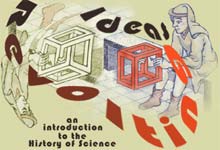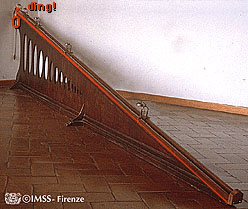
University of California, Irvine
Instructor: Dr. Barbara J. Becker

|
|
Notable Events in Galileo's Life (cont'd) |
|
1638 |
Discourses and Demonstrations Concerning Two New Sciences published at Leyden--a handbook for those who wish to learn the language and methods of the new physics |
|
|
A piece of wooden moulding or scantling, about 12 cubits long, half a cubit wide, and three finger-breadths thick, was taken; on its edge was cut a channel a little more than one finger in breadth; having made this groove very straight, smooth, and polished, and having lined it with parchment, also as smooth and polished as possible, we rolled along it a hard, smooth, and very round bronze ball. Having placed this board in a sloping position, by lifting one end some one or two cubits above the other, we rolled the ball ... noting ... the time required to make the descent. We repeated this experiment more than once in order to measure the time with an accuracy such that the deviation between two observations never exceeded one-tenth of a pulse-beat.... For the measurement of time, we employed a large vessel of water placed in an elevated position--

...It is evident by simple computation that a moving body starting from rest and acquiring velocity at a rate proportional to the time, will, during equal intervals of time, traverse distances which are related to each other as the odd numbers beginning with unity: 1, 3, 5; or considering the total space traversed, that covered in double time will be quadruple that covered during unit time; in triple time, the space is nine times as great as in unit time. And in general the spaces traversed are in the ratio of the squares of the times.... |
Philosophy is written in this grand book, the universe, which stands
continually open to our gaze. But the book cannot be understood unless
one first learns to comprehend the language and read the letters in which
it is composed. It is written in the language of mathematics, and
its characters are triangles, circles, and other geometric figures without
which it is humanly impossible to understand a single word of it; without
these, one wanders about in a dark labyrinth.
|
|
|